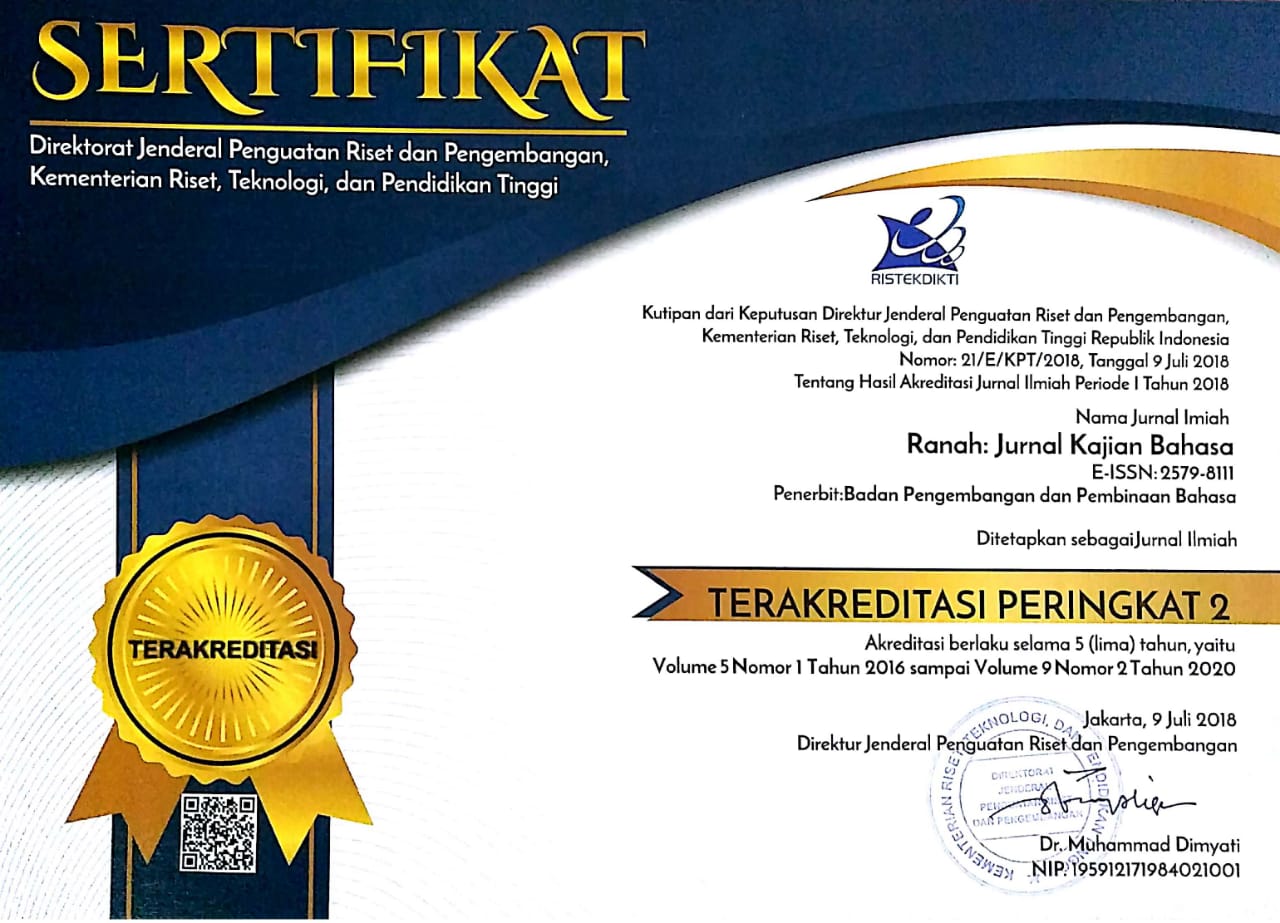Sifat Alami Gramatika Indonesia: Sistem Partikel Linguistik, Fungsi Penataan Konseptual, dan Representasi Kognitif
Abstract
Our article aims to characterize the conceptual architecture of Indonesian grammar theoretically through a cognitive semantic approach. In its implementation, we applied introspective reflection on language data in the form of sentences that have been collected into a corpus. Applying the Conceptual Structuring System (Talmy, 2000b), we introspected the semantic function of grammar elements and their coherence with lexical elements that constitute sentences. We propose that conceptualization in the Indonesian language relies on the system of pairing and connecting morphemes, or what will be regarded here as linguistic particles. In other words, a sentence is a composition of complex particles that externalizes the organization of ideas, thoughts, or concepts as a predication construed into cognitive representations in the form of event schemas. Furthermore, the conceptual organization expressed as predication configures conceptual meaning with respect to spatiotemporal domains. This article sheds light on the cognitive architecture that conceptualizes Indonesian grammar, contributing to a deeper understanding of its structural characteristics and the experience of language meaning-making.
Abstrak
Penelitian ini bertujuan untuk mengkarakterisasikan arsitektur konseptual gramatika Indonesia secara teoretis melalui pendekatan semantik kognitif. Pada pelaksanaannya peneliti menerapkan refleksi introspektif atas data bahasa berupa kalimat yang telah dikumpulkan ke dalam korpus. Menerapkan Sistem Penataan Konseptual (Talmy, 2000b), peneliti mengintrospeksi fungsi semantik unsur gramatika dan kesinambungannya dengan unsur leksikal yang mengkonstitusikan kalimat. Peneliti memproposisikan konseptualisasi dalam bahasa Indonesia bertumpu pada sistem pemasangan dan penghubungan morfem atau apa yang akan disebut di sini sebagai partikel linguistik. Dalam kata lain, kalimat adalah susunan partikel kompleks yang mengeksternalisasikan organisasi ide, pikiran, atau konsep sebagai sebuah predikasi yang ditafsirkan ke dalam representasi kognitif berupa skema kejadian. Selanjutnya, organisasi konseptual yang dinyatakan sebagai predikasi mengkonfigurasi makna konseptual berdasarkan domain ruang dan waktu. Artikel ini mencerahkan arsitektur kognitif yang dikonseptualisasikan gramatika Indonesia, dalam cara yang mengkontribusikan pemahaman lebih dalam tentang karakteristik struktural dan pengalaman pemaknaan bahasa.
Keywords
Full Text:
PDFReferences
Athanasopoulos, P., & Bylund, E. (2013). Does grammatical aspect affect motion event cognition? A Cross-Linguistic comparison of english and swedish speakers. Cognitive Science, 37(2), 286-309. https://doi.org/10.1111/cogs.12006
Baker, C. F., Fillmore, C. J., & Lowe, J. B. (1998). The Berkeley FrameNet Project. Proceedings of the 17th International Conference on Computational Linguistics, 1, 86-90. https://doi.org/10.1016/S0022-0248(98)00552-1
Bybee Joan. (2006). From usage to grammar: the mind's response to repetition. Language, 82(4), 711-733.
https://doi.org/10.1353/lan.2006.0186
Choi, H. Y. J. (2019). A corpus based analysis of -kan and -i in Indonesian [Nanyang Technological University].
https://doi.org/10.32657/10356/136955
Croft, W. (2016). Typology and the future of Cognitive Linguistics. Cognitive Linguistics, 27(4), 587-602. https://doi.org/10.1515/cog-2016-0056
Daddesio, T. C. (2013). 2. Cognition in the wake of the linguistic turn. In On Minds and Symbols. DE GRUYTER.
https://doi.org/10.1515/9783110903003.45
Denistia, K., & Baayen, R. H. (2019). The Indonesian prefixes PE- and PEN-: A study in productivity and allomorphy. Morphology, 29(3), 385-407. https://doi.org/10.1007/s11525-019-09340-7
Divjak, D., Levshina, N., & Klavan, J. (2016). Cognitive Linguistics: Looking back, looking forward. Cognitive Linguistics, 27(4), 447-463. https://doi.org/10.1515/cog-2016-0095
Evans, V. (2005). The meaning of time: Polysemy, the lexicon and conceptual structure. Journal of Linguistics, 41(1), 33-75. https://doi.org/10.1017/S0022226704003056
Evans, V. (2012). Cognitive linguistics. Wiley Interdisciplinary Reviews: Cognitive Science, 3(2), 129-141. https://doi.org/10.1002/wcs.1163
Evans, V., & Green, melanie. (2008). Cognitive Linguistics. In A Companion to Cognitive Science.
https://doi.org/10.1002/9781405164535.ch37
Fauconnier, G. (1999). Methods and Generalisations. Cognitive Linguistics: Foundations, Scope and Methodology, 95-128.
https://doi.org/10.1515/9783110803464.95
Fillmore, C. J. (1982). Fillmore - Frame Semantics.pdf.
Geeraerts, D. (2006). Cognitive Linguistics: Basic Readings (D. Geeraerts, R. Dirven, J. R. Taylor, & R. W. Langacker, Eds.). Mouton de Gruyter. https://doi.org/10.1515/9783110199901
Geeraerts, D. (2016). The sociosemiotic commitment. Cognitive Linguistics, 27(4), 527-542. https://doi.org/10.1515/cog-2016-0058
Gibbs, R. W., & Colston, H. L. (1995). The cognitive psychological reality of image Schemas and their transformations. Cognitive Linguistics, 6(4), 347-378. https://doi.org/10.1515/cogl.1995.6.4.347
Gonzales-Marques, M., Mittelberg, I., Coulson, S., & Spivey, M. J. (2007). Methods in Cognitive Linguistics (Vol. 18). John Benjamins Publishing. https://doi.org/10.1075/arcl.6.13val
Hedblom, M. M., Kutz, O., & Neuhaus, F. (2016). Choosing the Right Path: Image Schema Theory as a Foundation for Concept Invention. Journal of Artificial General Intelligence, 6(1), 21-54. https://doi.org/10.1515/jagi-2015-0003
Huette, S., Winter, B., Matlock, T., Ardell, D. H., & Spivey, M. (2014). Eye movements during listening reveal spontaneous grammatical processing. Frontiers in Psychology, 5(MAY), 1-7.
https://doi.org/10.3389/fpsyg.2014.00410
Johnson, C. R., Petruck, M. R. L., Baker, C. F., Ellsworth, M., Ruppenhofer, J., & Fillmore, C. J. (2003). FrameNet: Theory and Practice. http://www.icsi.berkeley.edu
Lakoff, G. (1987). Women, Fire, and Dangerous Things: What Categories Reveal about the Mind. In The University of Chicago Press. https://doi.org/10.1525/ae.1988.15.4.02a00410
Lakoff, G. (2004). don't think of an elephant! Know your Values and Frame the Debate. Chelsea Green Publishing Company.
Lakoff, G., & Johnson, M. (1980). Metaphors We live By. University of Chicago Press.
Lakoff, G., & Johnson, M. (1999). Philosophy in The Flesh The Embodied Mind and Its Challenge to Western Thought (Issue c). Basic Books.
Langacker, R. W. (2008). Cognitive Grammar : An Introduction. https://doi.org/10.1093/acprof:oso/9780195331967.001.0001
Langacker, R. W. (2009). Investigations in Cognitive Grammar (D. Geeraerts, R. Dirven, J. R. Taylor, & R. W. Langacker, Eds.). Walter de Gruyter. https://doi.org/10.1515/9783110214369
Langacker, R. W. (2016). Reflections on the Functional Characterization of Spatial Prepositions. Belgrade English Language and Literature Studies, 1, 9-34.
https://doi.org/10.18485/bells.2009.1.1
Mardiah, Z. (2021). PREPOSISI "di" DALAM PERSPEKTIF SEMANTIK KOGNITIF. JURNAL PESONA, 7(2), 148-161.
https://doi.org/10.52657/jp.v7i2.1506
Montero-Melis, G., & Bylund, E. (2017). Getting the ball rolling: The cross-linguistic conceptualization of caused motion. Language and Cognition, 9(3). https://doi.org/10.1017/langcog.2016.22
Muwaffaq, T., Piantari, L. L., Hidayah, N. D., & Kohar, S. S. (2021). Conceptual Restrictions in Indonesian Grammar. Advances in Social Science, Education and Humanities Research.
https://doi.org/10.2991/assehr.k.211226.027
Muwaffaq, T., Piantari, L. L., Hidayah, N. D., & Kohar, S. S. (2022). Conceptual Restrictions in Indonesian Grammar. Proceedings of the International Congress of Indonesian Linguistics Society (KIMLI 2021), 622(Kimli), 133-136.
https://doi.org/10.2991/assehr.k.211226.027
Nasrullah, R., & Budiman, A. (2022). Kajian Linguistik Kognitif Pada Imbuhan Ber- dalam Bahasa Indonesia. Ranah: Jurnal Kajian Bahasa, 11(2), 478-488. https://doi.org/10.26499/rnh.v11i2.3937
Noguchi, H. (2011). Talmy ' s Dichotomous Typology and Japanese Lexicalization Patterns of Motion Events Talmy ' s Typology of Lexicalization Patterns of Motion Events. TESOL & Applied Linguistics, 11(1), 29-47.
Papafragou, A., Hulbert, Justin, & Trueswell, J. (2010). Does language guide event perception? Evidence from eye movements. Cognition, 108(1), 1-28.
https://doi.org/10.1016/j.cognition.2008.02.007
Ramonda, K. (2017). Goldberg's construction grammar. January 2014.
Richardson, D. C., Spivey, M. J., Barsalou, L. W., & McRae, K. (2003). Spatial representations activated during real-time comprehension of verbs. Cognitive Science, 27(5), 767-780.
https://doi.org/10.1016/S0364-0213(03)00064-8
Talmy, L. (1985). Lexicalization patterns: Semantic structure in lexical forms. Language Typology and Syntactic Description, 3(1), 57-149.
Talmy, L. (2000a). Toward a Cognitive Semantics, vol. The MIT Press.
https://doi.org/10.7551/mitpress/6847.001.0001
Talmy, L. (2000b). Toward a Cognitive Semantics: Vol 1 Concept Structuring Systems. Massachusetts Institute of Technology.
https://doi.org/10.7551/mitpress/6847.001.0001
Talmy, L. (2017). The Targeting System of Language. In The MIT Press. https://doi.org/10.7551/mitpress/9780262036979.001.0001
Tomasello, M. (2000). The item-based nature of children's early syntactic development. Trends in Cognitive Sciences, 4(4), 156-163. https://doi.org/10.1016/S1364-6613(00)01462-5
Utami, S. R. (2017). Pembelajaran Aspek Tata Bahasa dalam Buku Pelajaran Bahasa Indonesia. AKSIS: Jurnal Pendidikan Bahasa Dan Sastra Indonesia, 1(2), 189-203.
https://doi.org/10.21009/AKSIS.010203
William Croft. (2007). the Origins of Grammar in the Verbalization of Experience. Cognitive Linguistics, 1(2010), 1-48.
https://doi.org/10.1515/COG.2007.021
William Croft. (2010). Relativity, linguistic variation and language universal. CogniTextes, 4, 1-19.
https://doi.org/10.4000/cognitextes.303
William Croft, & Cruse, A. D. (2004). Cognitive Linguistics. Cambridge University Press.
https://doi.org/10.1017/CBO9780511803864
Zakiyah, M., Fiaji, N. A., & Zulvarina, P. (2018). Semantik Prototipe Korupsi: Kajian Linguistik Kognitif. RETORIKA: Jurnal Bahasa, Sastra, Dan Pengajarannya, 11(2), 164.
https://doi.org/10.26858/retorika.v11i2.5137
Zlatev, J. (2010). Phenomenology and Cognitive Linguistics. In Handbook of Phenomenology and Cognitive Science.
https://doi.org/10.1007/978-90-481-2646-0_23
Zlatev, J. (2016). Turning back to experience in Cognitive Linguistics via phenomenology. Cognitive Linguistics, 27(4).
https://doi.org/10.1515/cog-2016-0057
Zlatev, J. (2018). From Gognitive to Integral Linguistics and Back Again. Intellectica. Revue de l'Association Pour La Recherche Cognitive, 56(2), 125-147.
https://doi.org/10.3406/intel.2011.1150
Zulkarnen, & Muwaffaq, T. (2018). Dictionary Meaning vs. Encyclopaedic Meaning of Halal: Comparing Meaning in Dictionaries with Frame Semantics for The Sake of Conceptual Understanding. 2ND ISIE (International Symposium of Islamic Epistemology), 95-104.
DOI: https://doi.org/10.26499/rnh.v12i1.3039
Refbacks
- There are currently no refbacks.








